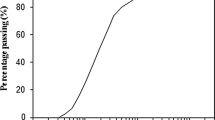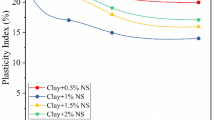Abstract
The nanoparticles are basically the smallest particles known in the soil environment. Soil being a particulate material and its essential particles have a different size range. On the other hand, nanoparticles range between 1 and 100 nm and most properties of nanoparticles are size-dependent. In this paper, an experimental study was conducted to study the improvement of strength characteristics of soil treated with SiO2 nanomaterial. Also, X-ray diffraction tests were performed on collected soil samples and nanomaterial. Furthermore, scanning electron microscope analysis was performed to identify the underlying mechanisms of nanomaterials. Soft soils of two types were collected and were treated with nano-silica (SiO2) additive at percentages of 0.5%, 1.0%, 1.5%, and 2.0%. The test outcomes revealed that the unconfined compressive strength increased significantly with increasing percentage of nano-silica. Moreover, a decrease in maximum dry density and increase in optimum moisture content of treated soil were observed. The addition of nanoparticles increased the sample’s reactivity even at an early age and subsequently strength was increased. Therefore, the main aim of this paper was to stabilize soft soil deposits for utilization of various geotechnical applications for sustainable environment.



















Similar content being viewed by others
References
Al-Rawas AA (2002) Microfabric and mineralogical studies on the stabilization of an expansive soil using cement by-pass dust and some types of slags. Can Geotech J 39(5):1150–1167. https://doi.org/10.1139/t02-046
Al-Swaidani A, Hammoud I, Meziab A (2016) Effect of adding natural pozzolana on geotechnical properties of lime-stabilized clayey soil. J Rock Mech Geotech Eng 8(5):714–725. https://doi.org/10.1016/j.jrmge.2016.04.002
ASTM Committee D-18 on Soil and Rock. Standard test methods for laboratory determination of water (moisture) content of soil and rock by mass. ASTM
ASTM Committee D-18 on Soil and Rock (2010) Standard test methods for liquid limit, plastic limit, and plasticity index of soils. ASTM International
ASTM D. 6913. Standard test methods for particle-size distribution (Gradation) of soils using sieve analysis
ASTM D (2006) Standard test method for unconfined compressive strength of cohesive soil. ASTM standard D2166
ASTM D (2010) Standard test methods for specific gravity of soil solids by water pycnometer. D854
ASTM D6528-17. Standard test method for consolidated undrained direct simple shear testing of fine grain soils
ASTM (2012) Standard test methods for laboratory compaction characteristics of soil using modified effort. D1557
Babu S, Joseph S (2016) Effect of nano materials on properties of soft soil. Int J Sci Res. 5:634–637
Bagherpour I, Choobbasti AJ (2003) Stabilization of fine-grained soils by adding microsilica and lime or microsilica and cement. Electron J Geotech Eng 8(B):1
Bahmani SH, Huat BB, Asadi A, Farzadnia N (2014) Stabilization of residual soil using SiO2 nanoparticles and cement. Constr Build Mater 14(64):350–359. https://doi.org/10.1016/j.conbuildmat.2014.04.086
Buhler RL, Cerato AB (2007) Stabilization of Oklahoma expansive soils using lime and class C fly ash. In: Problematic soils and rocks and in situ characterization, pp 1–10. https://doi.org/10.1061/40906(225)1
Changizi F, Haddad A (2016) Effect of nano-SiO2 on the geotechnical properties of cohesive soil. Geotech Geol Eng 34(2):725–733
Choobbasti AJ, Vafaei A, Kutanaei SS (2015) Mechanical properties of sandy soil improved with cement and nanosilica. Open Eng 5(1):111–116
Cokca E (2001) Use of class c fly ashes for the stabilizationof an expansive soil. J Geotech Geoenviron Eng 127(7):568–573. https://doi.org/10.1061/(ASCE)1090-0241(2001)127:7(568)
Dafalla M, Mutaz E, Al-Shamrani M (2015) Compressive strength variations of lime-treated expansive soils. In: IFCEE 2015, pp 1402–1409. https://doi.org/10.1061/9780784479087.126
Das BM, Sobhan K (2013) Principles of geotechnical engineering. Cengage Learning, Stanford
Díaz-Rodríguez JA, Antonio-Izarraras VM (2004) Mitigation of liquefaction risk using colloidal silica stabilizer. In: Proceedings of the 13th world conference on earthquake engineering, Vancouver, BC, Canada, pp 1–10
Dutta S, Mandal JN (2015) Model studies on geocell-reinforced fly ash bed overlying soft clay. J Mater Civil Eng 28(2):04015091. https://doi.org/10.1061/(ASCE)MT.1943-5533.0001356
Ghasabkolaei N, Janalizadeh A, Jahanshahi M, Roshan N, Ghasemi SE (2016) Physical and geotechnical properties of cement-treated clayey soil using silica nanoparticles: an experimental study. Eur Phys J Plus 131(5):134. https://doi.org/10.1140/epjp/i2016-16134-3
Ghazi H, Baziar MH, Mirkazemi SM (2011) Assess of the improvement of the behavior of soil strength in the presence of nanoscale additive. Assas J Sci Technol 45–50 (in Persian)
Gillott JE (1969) Study of the fabric of fine-grained sediments with the scanning electron microscope. J Sediment Res 39(1):90–105. https://doi.org/10.1306/74D71BEA-2B21-11D7-8648000102C1865D
Hussey NL, Cerato AB, Grasmick JG, Holderby ES, Miller GA, Tabet W (2010) An assessment of soil parameters governing soil strength increases with chemical additives. In: GeoFlorida 2010: advances in analysis, modeling and design 2010, pp 2702–2711. https://doi.org/10.1061/41095(365)274
Ikeagwuani CC, Nwonu DC, Eze C, Onuoha I (2017) Investigation of shear strength parameters and effect of different compactive effort on lateritic soil stabilized with coconut husk ash and lime. Niger J Technol 36(4):1016–1021. https://doi.org/10.4314/njt.v36i4.4
Inyang HI, Bae S, Mbamalu G, Park SW (2007) Aqueous polymer effects on volumetric swelling of Na-montmorillonite. J Mater Civil Eng 19(1):84–90. https://doi.org/10.1061/(ASCE)0899-1561(2007)19:1(84)
Jayasree PK, Balan K, Peter L, Nisha KK (2014) Volume change behavior of expansive soil stabilized with coir waste. J Mater Civil Eng 27(6):04014195. https://doi.org/10.1061/(ASCE)MT.1943-5533.0001153
Kate JM (2005) Strength and volume change behavior of expansive soils treated with fly ash. In: Innovations in grouting and soil improvement, pp 1–15. https://doi.org/10.1061/40783(162)19
Khalid N, Arshad MF, Mukri M, Mohamad K, Kamarudin F (2015) Influence of nano-soil particles in soft soil stabilization. Electron J Geotech Eng 2015(20):731–738
McKyes E, Yong RN (1971) Three techniques for fabric viewing as applied to shear distortion of a clay. Clays Clay Miner 19(5):289–293. https://doi.org/10.1346/CCMN.1971.0190504
Mir BA, Amin F, Majid B (2016) Some studies on physical and mechanical behaviour of dredged soil from flood spill channel of Jhelum river, Srinagar. Acta IngenierÃa Civil. https://doi.org/10.20936/AICV/160101
Mir BA (2015) Some studies on geotechnical characterization of dredged soil for sustainable development of Dal Lake and environmental restoration. Int J Tech Res Appl 12:04–09
Mir BA (2017) Some studies on mechanical behaviour of cement stabilized dredged soil from flood spill channel of Jhelum River Srinagar. In: International congress and exhibition. Sustainable civil infrastructures: innovative infrastructure geotechnology. Springer, Cham, pp 386–406. https://doi.org/10.1007/978-3-319-61612-4_32
Mir BA, Reddy HP Enhancement in shear strength characteristics of soft soil by using nanomaterials. EGRWSE2019, 013, v3, (Accepted)
Mohammadi M, Niazian M (2013) Investigation of nano-clay effect on geotechnical properties of Rasht clay. Int J Adv Sci Tech Res 3(3):37–46
Neethu SV, Remya S (2013) Engineering behaviour of nanoclays stabilized soil. In: Proceedings of Indian geotechnical conference, pp 22–24
Nohani E, Alimakan E (2015) The effect of nanoparticles on geotechnical properties of clay. Int J Life Sci 9(4):25–27. https://doi.org/10.3126/ijls.v9i4.12670
Ola SA (1981) Stabilization of maiduguri black cotton soils of Nigeria with sand. Bull Int Assoc Eng Geol 24(1):145–150. https://doi.org/10.1007/BF02595265
Petry TM, Little DN (2002) Review of stabilization of clays and expansive soils in pavements and lightly loaded structures—history, practice, and future. J Mater Civil Eng 14(6):447–460. https://doi.org/10.1061/(ASCE)0899-1561(2002)14:6(447)
Priyadharshini R, Arumairaj PD (2015) Improvement of bearing capacity of soft clay using nanomaterials. Int J Sci Res 4(6):218–221
Puppala A, Hoyos L, Viyanant C, Musenda C (2001) Fiber and fly ash stabilization methods to treat soft expansive soils. In: Soft ground technology, pp 136–145. https://doi.org/10.1061/40552(301)11
Rao SM, Venkatarama Reddy BV, Muttharam M (2000) Engineering behaviour of wood-ash-modified soils. Proc Inst Civil Eng Ground Improv 4(4):137–140. https://doi.org/10.1680/grim.2000.4.4.137
Staiger M, Bowen P, Ketterer J, Bohonek J (2002) Particle size distribution measurement and assessment of agglomeration of commercial nanosized ceramic particles. J Dispers Sci Technol 23(5):619–630. https://doi.org/10.1081/DIS-120015367
Yonekura R, Miwa M (1993) Fundamental properties of sodium silicate-based grout. In: Proceedings of the 11th Southeast Asia geotechnical conference, Singapore. vol 439, p e44
Zhang G, Germaine JT, Whittle AJ, Ladd CC (2004) Index properties of a highly weathered old alluvium. Geotechnique 54(7):441–451
Acknowledgements
The investigation reported in this paper forms a part of the research at Department of Civil Engineering, National Institute of Technology Srinagar (J&K). The support and assistance are gratefully acknowledged. Thanks are due to Faculty of Geotechnical Engineering Division and supporting staff of the Soil Mechanics laboratory and the office staff of Civil Engineering Department for their timely help during the course of investigation. The Authors thank the “CRF” Laboratory for conducting SEM tests.
Author information
Authors and Affiliations
Corresponding author
Rights and permissions
About this article
Cite this article
Samala, H.R., Mir, B.A. Some studies on microstructural behaviour and unconfined compressive strength of soft soil treated with SiO2 nanoparticles. Innov. Infrastruct. Solut. 5, 34 (2020). https://doi.org/10.1007/s41062-020-0283-3
Received:
Accepted:
Published:
DOI: https://doi.org/10.1007/s41062-020-0283-3




